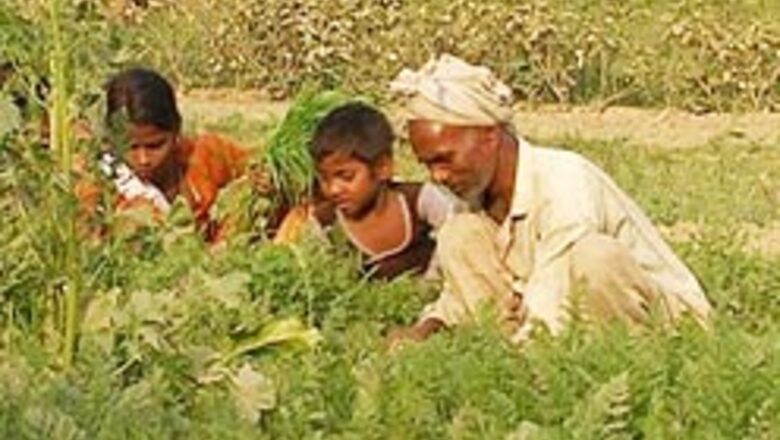
views
Kishan Kumar, a middle-aged farmer in Garhar village in southern UP’s Jalaun district, was a happy man in September as summer gave way to heavy downpours. Rains, scant in this region for the past six years, meant Kumar could plant wheat or pulses on his 3.5-acre field when the sowing season began in October.
The rain wasn’t the only blessing. A magnanimous Government had also waived off the Rs 15,000 he had borrowed from Triveni Regional Rural Bank in 2005 — an overdue debt that had made him ineligible for more loans during the previous three dry years.
But Kumar’s happiness was short-lived. He could not get a fresh loan in spite of making several trips to the bank even as the sowing season neared. “They (the bank officials) did not give any specific reason for not giving a loan. They just say there is no money,” he says.
Disheartened and trying to cut costs, Kumar has sown peas without any fertilisers this year and is reconciled to a poorer harvest.
Kumar is among the thousands of subsistence farmers across India who depend on unpredictable monsoons and borrowed money for their hand-to-mouth existence. The formal funding system routinely fails them — they languish in fat ledgers as defaulters, ineligible for fresh loans, and remain beholden to village shylocks. The Government’s much-touted Rs 72,000-crore farm loan waiver scheme has only increased the burden of the dysfunctional rural banking system and introduced new shades of grey into the profile of the indebted farmer.
To assess the impact of the loan waiver scheme, Forbes-Network18 visited six villages in three districts of Bundelkhand, a cluster of 15 semi-arid districts spread across southern UP and northern Madhya Pradesh. The region is populated mostly by marginal farmers who eke out one crop every year if the rain gods smile on them. Rabi (winter crop) is the only real cropping season in Bundelkhand. There is little farming during the kharif season because of lack of water.
The per capita income of the seven districts that fall in UP is just half of the national average of Rs 17,978. Almost 70 per cent of farmers here hold less than 2.5 acres. There are 228 bank branches in these seven districts, many of them in headquarters such as Jhansi, Orai and Hamirpur. Only Rs 35 of every Rs 100 collected as deposits is lent to borrowers, compared to the national average of Rs 60. In Jalaun district, which has 937 villages, there are just 45 branches of state-owned banks, 20 of them in the district centre of Orai, according to RBI figures as of April 2003. It also has 37 regional rural bank branches.
These largely ill-equipped and short-staffed banks are tasked with implementing their share of the Rs 72,000-crore farm loan waiver announced by then finance minister P. Chidambaram. But, like numerous other state-sponsored programmes, the debt relief scheme too is poorly implemented and shows up the infirmities of the formal banking channels in rural India. The lender of last resort remains the village sahukaar or money lender.
DESPERATE MEASURES
Mohan Singh, another Garhar farmer, rushed to the village money lender to borrow. The money lender will charge him an annualised interest rate of 50-60 per cent — a bank loan would have cost only 8-9 percent even after paying a ‘cut’ to the loan officer for speedy disbursement, an almost standard practice, say villagers. But at least he will have money to buy seeds and fertilizer before the sowing season is over. After surviving successive drought years, he did not want to let go of the rain-soaked opportunity for better produce from a region where only 40 per cent of the land is irrigated.
“Kya varsha jab krishi sukhane” is an oft-quoted proverb in the region, which means a good rainfall has little meaning after the crop has dried up. In the current context, it is the timely availability of credit — for diesel for bore-well pumps, fertilizers, seeds and labour — that holds the key to producing a good crop. Farmers need money on time because the sowing window is narrow.
For example, the sub-surface soil needs to be moist up to about an inch-and-a-half to sow wheat. As days wear on after the last rain, the moisture disappears and the roots will not hold. The best months for sowing are October and November after which any amount of loans is useless. And this time, not many are getting money on time, regardless of their repayment behaviour.
Take Mohan Kumar and another farmer Jagdish. Mohan has repaid Rs 20,000 borrowed four years ago while Jagdish has paid back only a fifth — Rs 6,000 — of his Rs 30,000 loan. Both have been denied new loans.
Officials at the local branch of Central Bank of India say that the manager, the sole authority to sanction loans, is on leave for two months. That would not, however, deter Mohan and Jagdish from sowing something — anything — in their fields.
UNINTENDED CONSEQUENCES
Dealers in inputs like seeds, fertiliser and agricultural implements confirm that farmers are increasingly gravitating towards non-institutional sources of credit.
“Our sales haven’t seen any decline,” says Ashok Bajpai, manager of the Krishak Seva Kendra in the Navin Mandi (the main market in Jalaun). “If the farmers do not get loans from the banks then they strike a deal with the Arhtiyas (middlemen), who provide them with crop loans and adjust the sum while buying the produce from the farmer after the harvest,” he adds.
Ramji Panday, an Arhtiya stationed in the mandi, confirms this. “The farmer will try to do anything to grow his crop especially in a year when it has rained well.” He has more offers from the farmers this year.
Havaldar Dilsukh Pradhan, the headman for two contiguous villages, Bhanga and Iqhara, echoes what most farmers are complaining about this year. “The banks have not issued many new loans this year. If timely credit is not available even a good rainfall will fail (to bring prosperity),” he says. Farmers in Garhar and nearby Amkhera fear production may fall by as much as 25 per cent.
Stories of new loans being denied abound across the districts of Jalaun, Hamirpur and Jhansi. Farmers estimate that fresh loans in the sowing season could have fallen as much as 80 percent.
The regional branch of the Central Bank of India, one of the state-owned banks in Bundelkhand, shows a sharp decline in new loans. Between April and October this year, the total amount of farm loans fell by over 13 percent or Rs 1.6 crore over the same period last year. Officials at the regional office, which covers seven districts and 36 branches, lamely explained that “loans will pick up since this region often resorts to late sowing”.
Head of the Bundelkhand unit of the Bhartiya Kisan Union, Balram Lambardar, believes banks are holding back new loans because they feel that most farmers do not intend to repay. “Banks will never admit but it is true across Bundelkhand. They have held back new loans. Unfortunately, the farmer’s dependence on the non-institutional sources is likely to increase this time because they do not want to miss out on the good rainfall,” he warns. That means a good season, ironically, would make the farmer even more indebted.
Professor at the National Centre for Agricultural Economics and Policy Research (NCAP) in New Delhi, Ramesh Chand, says the share of credit in input costs has doubled in the past five years. Chand is not surprised at the banks struggling to give loans. “Instructions to the banks reached late and it is obvious that they would not be proactive when doling out waivers,” he said.
Waiver was never an option recommended by the R Radhakrishna committee report on agricultural indebtedness released last year, says Associate Professor at the Indira Gandhi Institute of Development Research (IGIDR) in Mumbai, Srijit Mishra.
Mishra, who helped prepare the report which forms the basis of the farm loan waiver scheme, says one of the key recommendations was to save the farmers from the usurious clutches of the money lender by transferring their informal debt to formal institutions. Instead, “The loan waiver scheme is merely a book-keeping exercise that has helped banks more than anybody else. It has only addressed the symptom (indebtedness) and not the problem (of reducing risks and making agriculture more remunerative),” he says.
STRESSED SYSTEM
Bank officials, at the village level branches of Amkhera, Garhar and Chikausi, on conditions of anonymity, admitted to at least 20 per cent drop in new loans this rabi season. One of the bankers also admitted that banks have been “cautious” in giving loans this time since the waiver had ruined the credit culture and they are not sure if the farmer has any real intent of paying back.
“Thanks to the waiver, the number of farmers approaching the bank for fresh loans has almost doubled. But we have to be careful in lending. If a person has been a regular in his repayments earlier then we would prefer him,” says one official who did not wish to identified.
They also blame shortage of staff and the increased burden on account of daily payments for the National Rural Employment Guarantee Scheme (NREGS) for the inefficiency.
“Every day I get around 100 people who either want to deposit or withdraw money from their NREGS accounts. There is simply not enough time to process all the applications for the fresh loans,” says the official.
“How can the same system and same number of officials suddenly handle all the burden of making detailed lists of the loan waiver (which has continued till the end of October) as well as the NREGS payments, alongside regular work? But I am positive that new loans figure will pick up in the days to come,” says the lead bank manager for Jalaun, L P Prabhakar of Allahabad Bank. Prabhakar could not say how many loans were given so far because the data would be compiled only after December.
The nuances of the loan waiver scheme have also delayed its implementation. Assistant Regional Manager of Central Bank of India in Jhansi, B R Chavali, said bankers were still not clear about the RBI guidelines on giving new loans to those who had more than 5 acres of land and were eligible for a relief of 25 per cent (up to a maximum of Rs 20,000) provided they paid up their remaining 75 per cent in three installments at pre-specified deadlines. Initially the deadlines had been set for September 30, 2008, March 31, 2009 and June 30, 2009, but were later extended by a month each.
“I have written a letter asking my superiors whether a farmer who has missed the deadline for the first installment but ready to pay up the next two before the second deadline, is eligible for new loans or not,” said Chavali. He wrote the letter on November 19 and was awaiting a reply at the fag end of the sowing season.
“The guidelines are silent on such a possibility while there are a lot of farmers who would fall under such a category. It is left to the individual banker,” he says.
It is ironic that a scheme that is supposed to benefit the farmers is not only overloading the creaking financial system that serves them, but also increasing the inefficiencies of both banking and farming. It will only result in damaging productivity and burgeoning debt. The then finance minister P Chidambaram’s rhetoric-laced promise of a debt pardon had given farmers a hope. But that may remain just a promise of hope.
Udit Misra is Principal Correspondent for the new business magazine to be launched by Network18 in alliance with Forbes, USA.



















Comments
0 comment